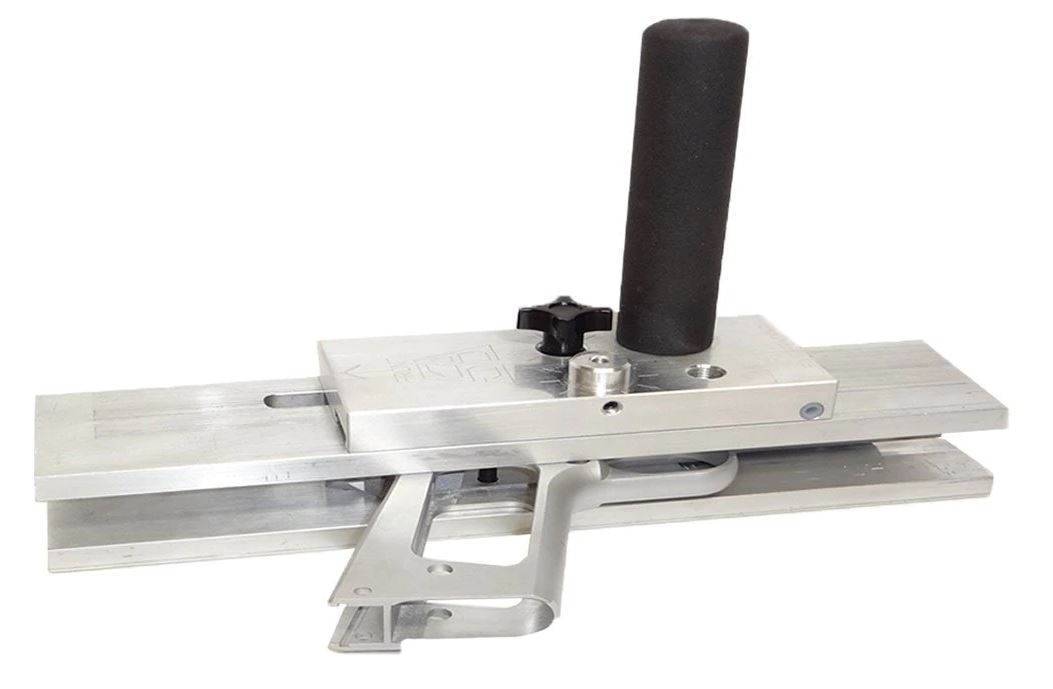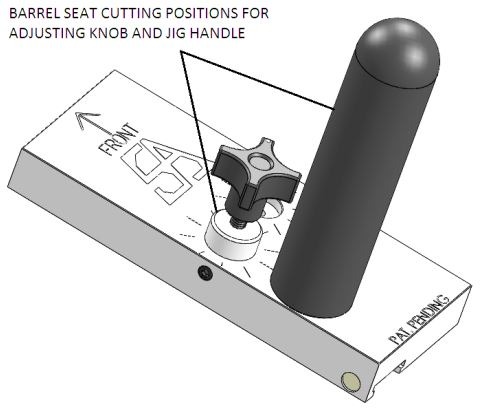How To Build A 1911 Pistol From Scratch
The 1911 needs no introduction. If you’re reading this, you’ve already made the commitment to build one of the greatest handguns ever made. Rest assured, building your 1911 at home is also 100% legal as long as you can otherwise legally own a firearm. We’ll walk you through everything you need to know. Here’s how to build your own 1911 at home.
First, Buy a 1911 80% Frame
Contents
This from-scratch build starts with an entirely new type of 1911 frame. That is, the Stealth Arms series of 80% frames. They’re just like any other 80% lower (read this guide if you don’t know what one is) and they’re made from billet 6061-T6 aluminum. This is an upgrade over the 1911’s steel frames, which are heavy and can’t be fabricated easily by hand.
This compares Government, Commander, and Officer 1911 frames.
The Stealth Arms frames come full-size, 5″ (Government) or 4.25″ (Commander) configurations. Both frames utilize the same parts to assembly, except for the barrel and slide, which are both shorter on the Commander. No sub-compact 80% frame is available for the Officer 1911 at this time.
80% Frames: State vs. Federal Law
These 80% frames are considered receiver blanks by the Bureau of Alcohol, Tobacco, and Firearms. They’ve been determined by the agency to be nonfunctioning, incomplete units that are not defined as firearms under federal law. That means you can buy, ship, own, and build one without having to utilize an FFL or gun dealer. However, state laws vary. Some states have banned 1911 frames, 80% lowers, and generally, gun-building kits and components. Always check your local and state laws before buying or building a firearm or parts. Our Shipping & Returns policy provides a list of restricted states, but you must perform your own research or consult legal counsel if you’re unsure.
Next, Buy a Stealth Arms 80% Jig
The 80% jig is the drilling template and cutting tool for finishing your 1911’s frame blank. The jig we sell comes from Stealth Arms and it’s also made in the USA. It’s easy to use (requiring no special tools) and it’s made to work with any of the available frames and build kits we sell. The jig will hold your 80% frame in place, showing you where to drill and cut the frame blank for the slide, barrel, and parts kit.
The jig includes:
- Right-hand side plate
- Left-hand side plate
- Cutting car
- Spacer block
- Cutting handle w/ knob
- Rail cutting blade (installed)
- Barrel seat cutting blade (installed)
- (2) set screws for securing frame and jig
- #35 drill bit
- #22 drill bit
- 5/32 Allen wrench
- 3/32 Allen wrench
- (1) 1-oz. bottle cutting fluid
The other tools you’ll need for this project are a vise, a black marker, and a drill press or vertically stabilized hand drill. Using the jig requires no milling machine or specialty tools. All cutting is done by hand with the car. The carbide blades used for cutting the frame are already installed on the cutting car, pictured above with the black handle.
Machining Your Frame
With the build kit and jig ready to go, it’s time to start cutting and drilling our frame blank. We’ll walk you through each step with illustrations. Go ahead and download the written instructions, too. The steps required to complete your frame for final assembly are simple:
- Cut the slide
- Cut the barrel setting
- Drill the hammer pin hole
- Drill the sear pin hole
#1: Assemble the frame blank and jig
Parts required:
- RH side plate
- LH side plate
- 0.157 dowel pin
- 0.201 dowel pin
- M5 x .8 Allen-head bolt
Grab your frame blank and both jig plates. Orient each plate so the interior cut-outs on each plate line up with the shape of the frame. Each plate is engraved at the barrel end, “LH” and “RH”. 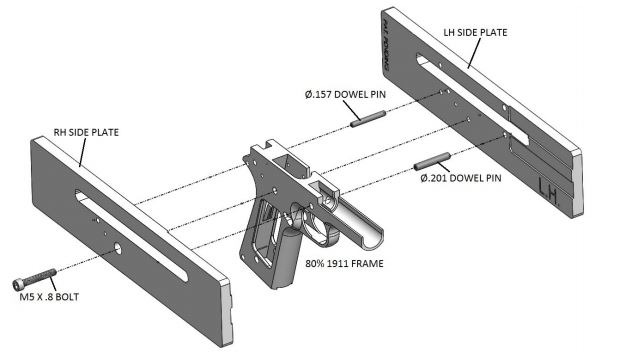
#2: Drill the hammer and sear pin holes
Parts required:
- #22 drill bit
- #35 drill bit
- Drill press or vertical drill
Lay the frame and jig assembly on its side. Your assembly must be perfectly flat and leveled under your drill. If not, the holes will not allow you to assemble your finished frame and parts kit. Insert the #22 bit in your drill’s chuck and tighten it. Next, orient the bit so the hammer pin hole on the jig side plate is lined up with the bit, pictured below. 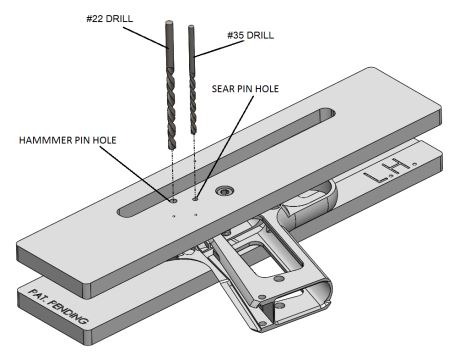
#3: Prep the cutting car blade for the slide rail
Parts required: With your pin holes drilled, half your machining is already completed! Pretty easy, right? This next step isn’t difficult, either. Grab the cutting car and look underneath. Note the set screw holding the guide boss and slide cutting blade, pictured below. 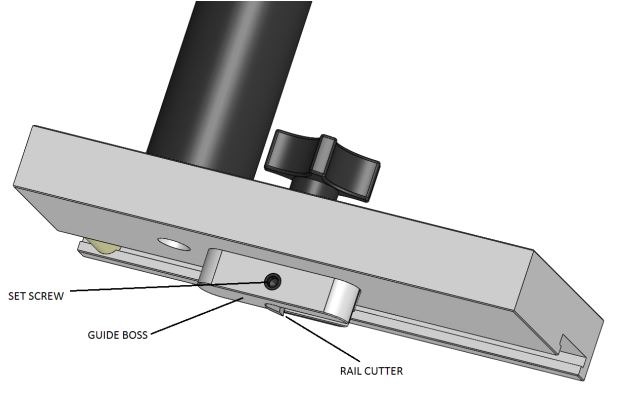
#4: Install the adjustment knob and handle
Parts required:
- Cutting handle
- Adjustment knob
Orient the cutting car so it’s top-down with the front facing away from you. Insert the handle in the bottom-right hole and thread it in place until tight. Next, insert the cutting blade’s adjustment knob in the top-right hole and thread it in place: 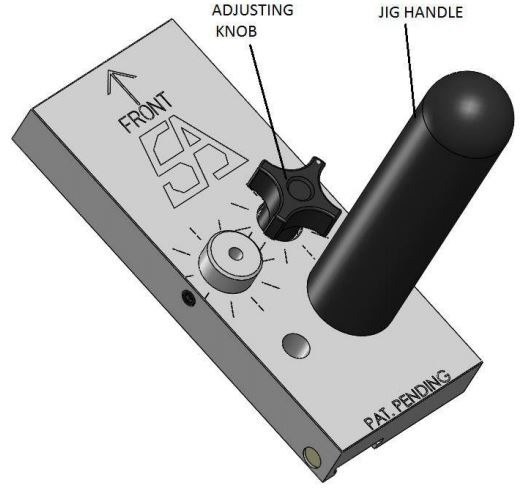
#5: Install the spacer block into the LH side plate
Parts required: Before cutting the slide rails, the jig and frame blank need to be secured in your vise. This applies pressure to the assembly. To keep the integrity of the jig, insert the spacer block into the side plate that are you are not cutting. If you want to follow the illustrations, insert the spacer block into the LH side plate as shown: 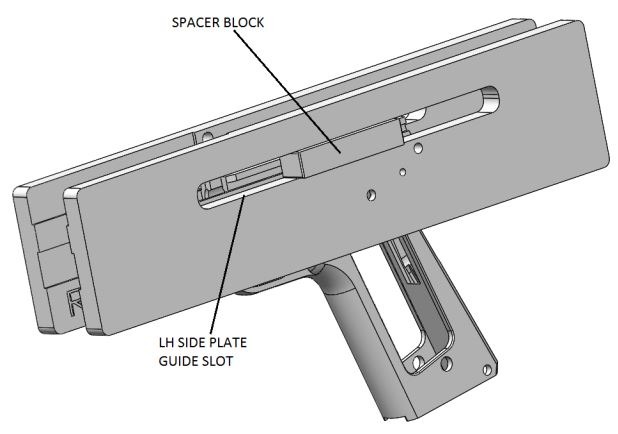
#6: Secure your jig in the vise and lubricate
Parts required:
- Bench vise
- Lubricating oil
Orient the frame and jig assembly so the LH side plate is secured in the jig. Ensure the barrel end of the frame is pointed toward you: 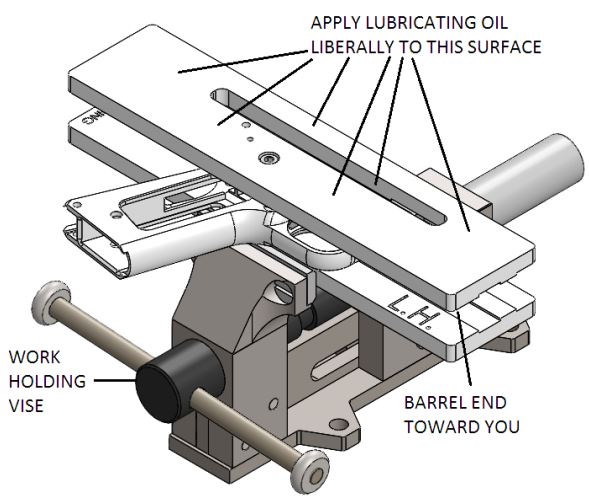
#7: Set the car atop the jig and “zero out” the blade
Parts required: Rest the cutting car atop the RH jig side plate, but don’t move it yet. The guide boss containing the blade should sit inside the open slot on the jig’s side plate: 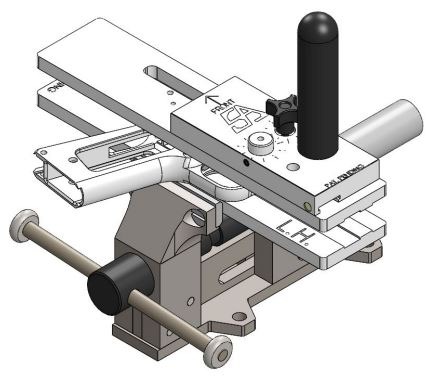
#8: Mark the zero/staring position on the jig
Parts required: Now you need to mark the starting position on the cutting car with a marker. An example starting position is illustrated below, in red. See the notches on the cutting car, underneath the adjustment knob? There are ten (10) notches in total. Each notch represents 1/10th of a revolution. There is also a small white dot on one of the ears of the knob: 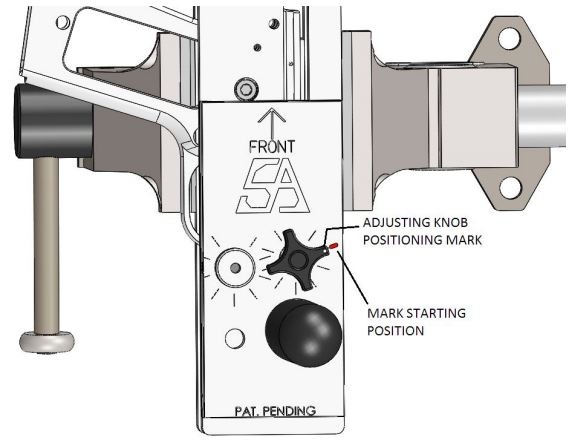
#9: (Finally) cut the slide rails!
You’re finally ready to cut! With the jig lubed up, the blade zeroed, and the starting position clearly marked, you can begin moving the cutting car forward on the frame. This will remove aluminum from the frame, carving out each slide rail: 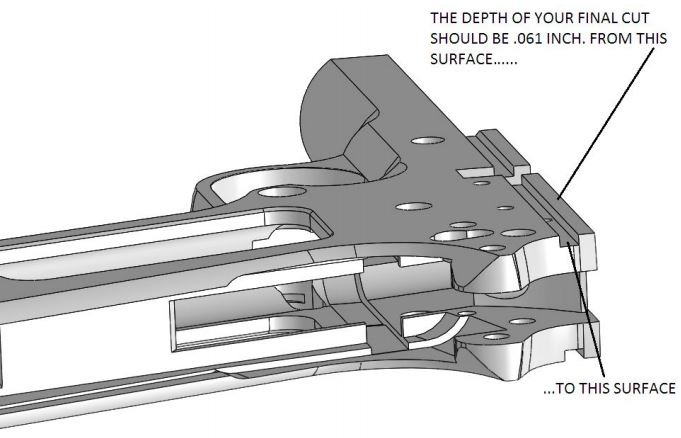
Repeat steps 6 thru 9 for the opposite side of the frame.
Once you’ve completed the slide rails on both sides of the frame, you can move the frame and jig from the vise. Take a break, come back, and get ready for the machining final step: Cutting the barrel seat.
#10: Prepare your work to cut the barrel seat
First, disassemble the frame from the jig by removing the M5 x .8 Allen-head screw and dowel pins. Take a moment to inspect the frame, and clean off any debris. Re-secure the frame and jig by relocating the dowel pins and re-tightening the screw as shown below: 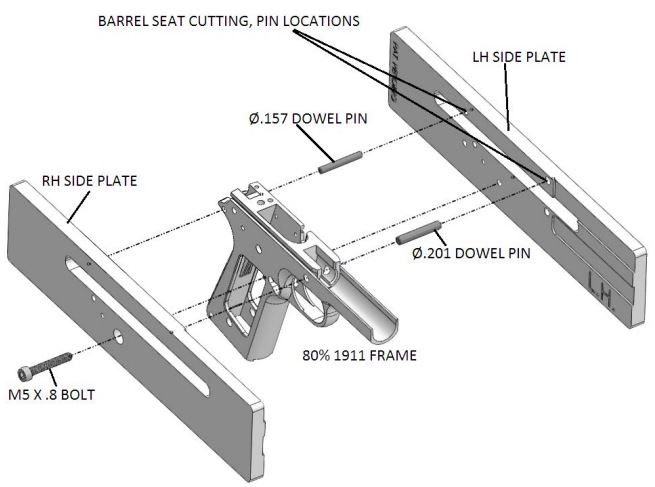
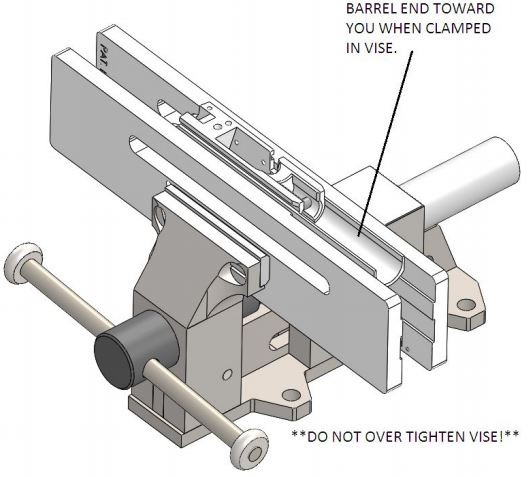
#11: Zero the barrel seat blade, cut the seat
To begin cutting the barrel seat, position the car atop the frame and jig as shown below. Apply plenty of lubricating oil to all the contacted surfaces just like before: 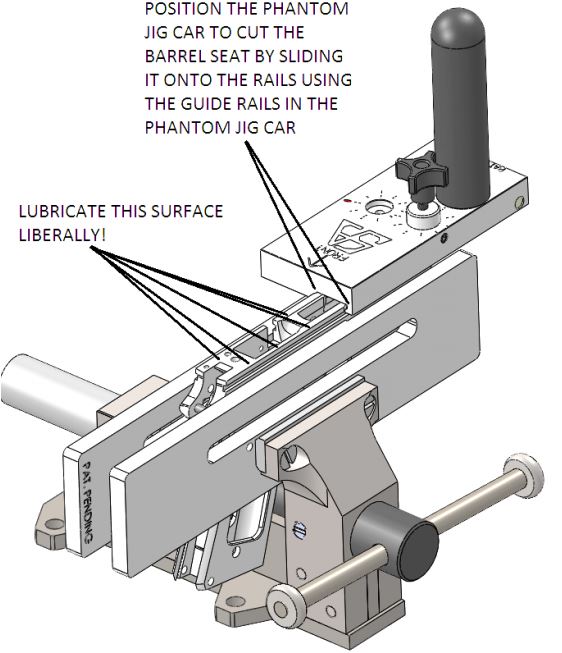
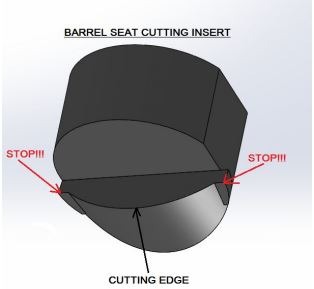
Your 1911 Frame is Complete
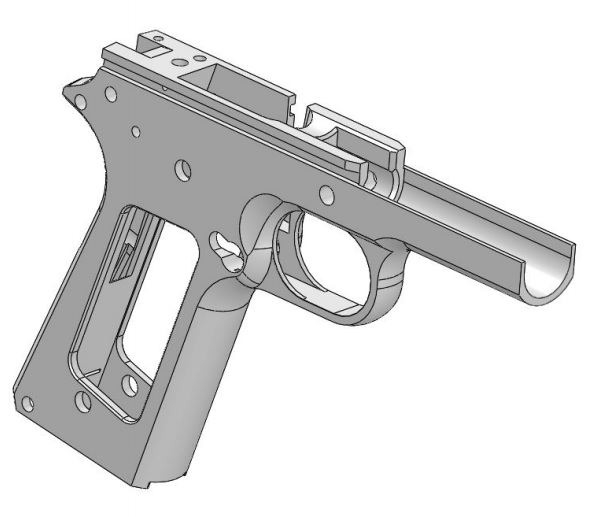
Final Assembly
With your frame finished, it can be assembled with proper 1911 parts of your choice. These frames work with all retail 1911 parts chambered in 9mm and .45 ACP, with slides, barrels, and parts configured for Government and Commander frames.
Summary
Cutting and drilling the 80% 1911 frame is the hardest part of this entire project. But with the right tools – and by closely following instructions – you can have your own home-built 1911 ready for the range in a single afternoon. Need help with your build, or have questions about completing your frame blank? Give us a call or email us. We build black rifles and handguns in our spare time, too!
Last, Wallx.net sent you details about the topic “How To Build A 1911 Pistol From Scratch❤️️”.Hope with useful information that the article “How To Build A 1911 Pistol From Scratch” It will help readers to be more interested in “How To Build A 1911 Pistol From Scratch [ ❤️️❤️️ ]”.
Posts “How To Build A 1911 Pistol From Scratch” posted by on 2021-11-01 22:41:59. Thank you for reading the article at wallx.net
